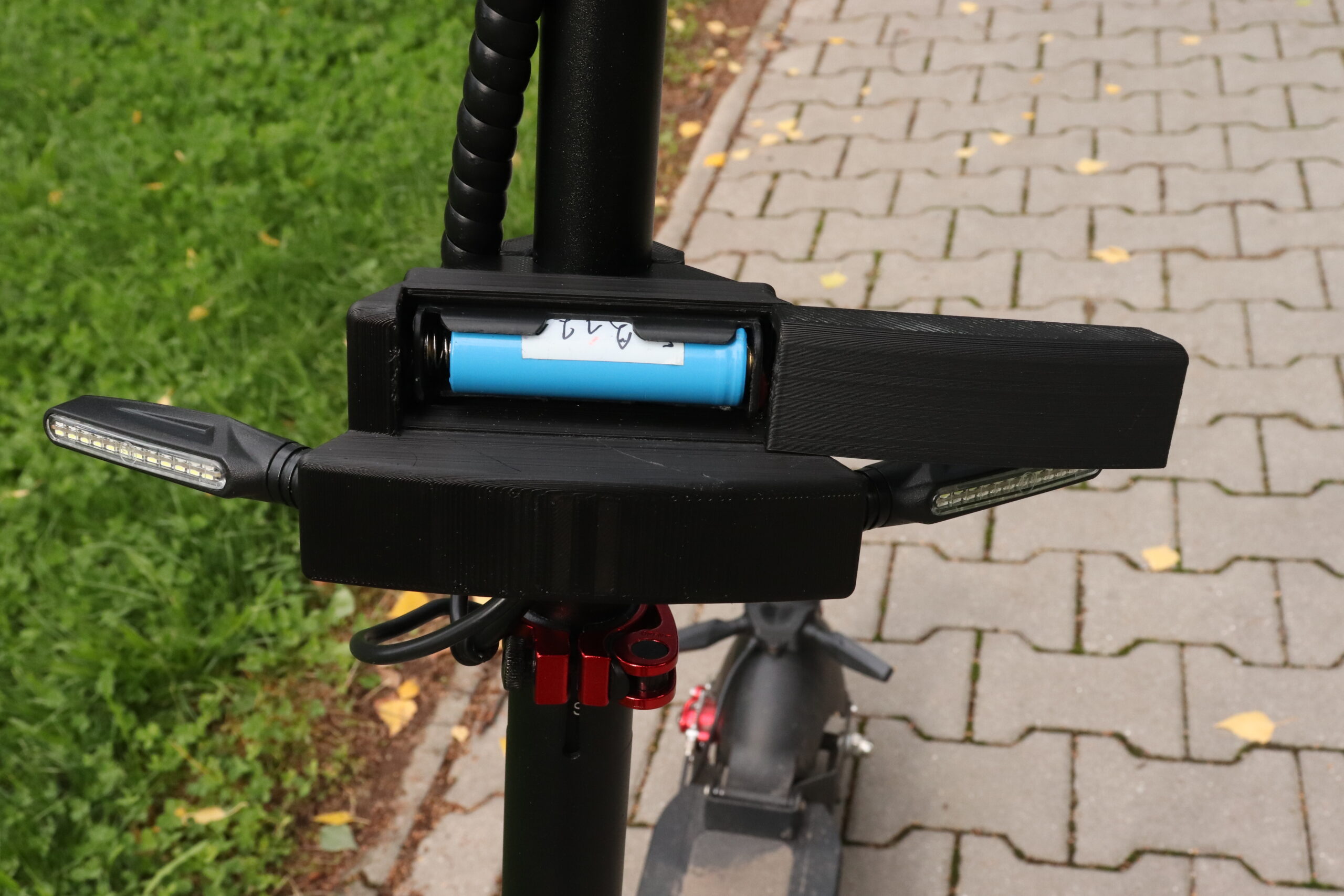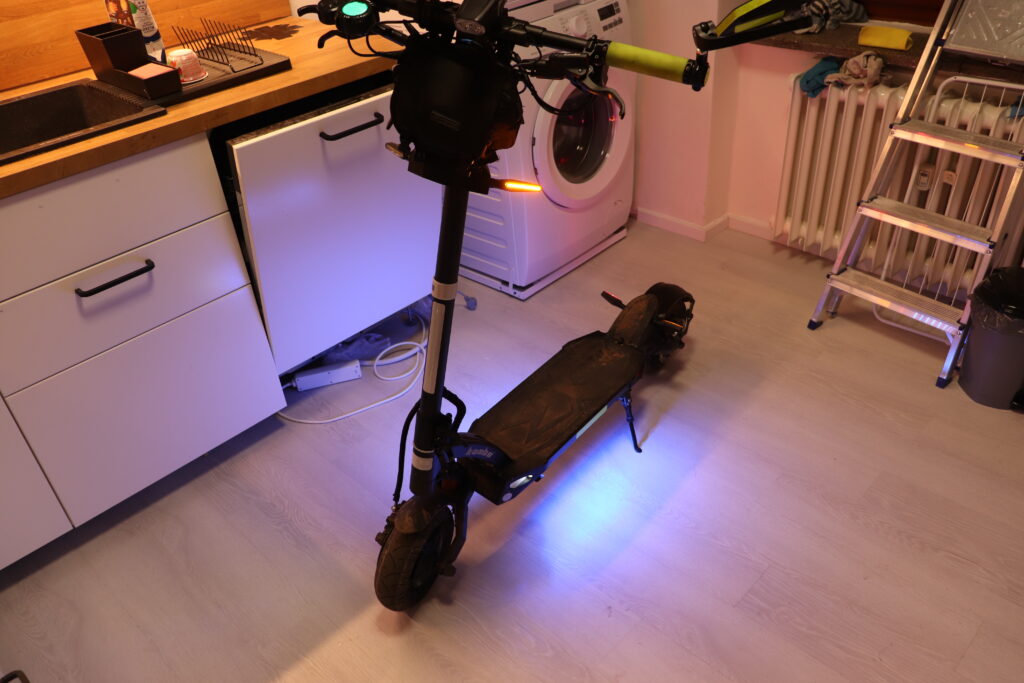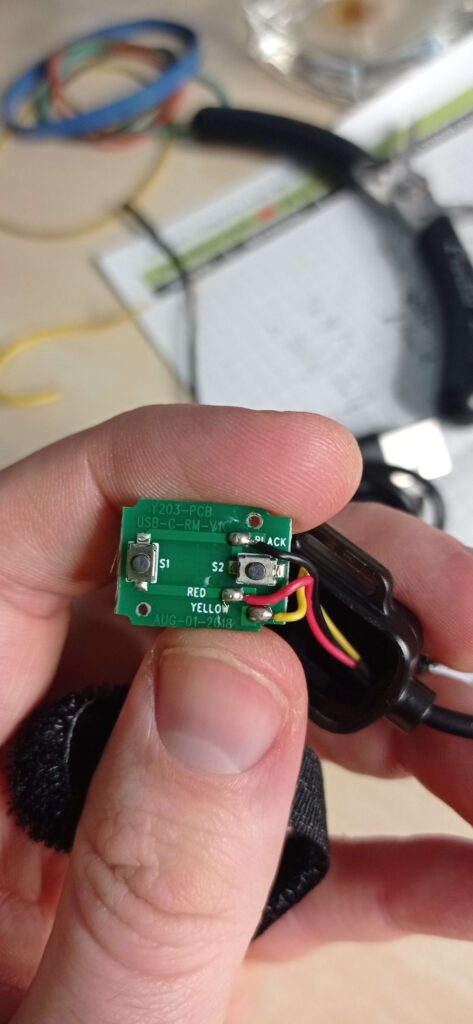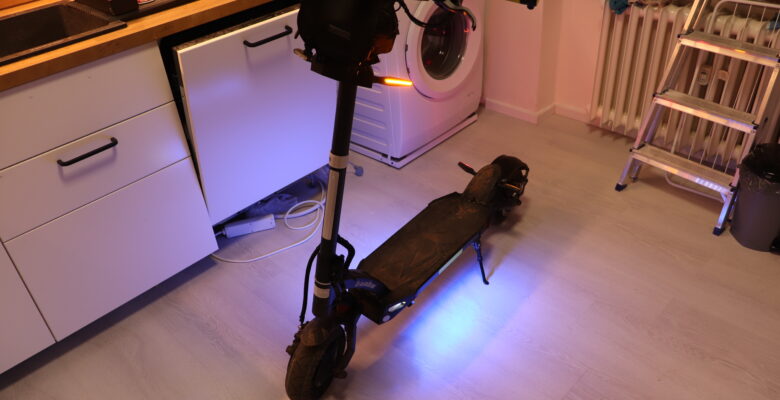Unfortunately, vast majority of e-scooters doesn’t have turn signals, and when they do, they usually suck – mounted on the bottom, not visible from both front and back, with very limited viewing angles and brightness. My City Boss RX5L belongs to the category with no blinkers. Well, used to – I’ve made it my own solution.
Worse video: https://youtube.com/shorts/XilJLzlrK84
How I got to doing it myself
Since I got my e-scooter, it was quite clear to me that I needed turn signals. Not indicating when you turn is quite dangerous and irresponsible. However, letting hands off the handle bars is even more dangerous; the stability goes down significantly because of the small wheels and stem angle. Plus I have the brake on one hand and the throttle on the other, so indicating with hands means that I can’t either break or speed up. And thus I started looking for possible solutions.
The legs way
I somewhere read an idea to indicate with legs. It actually works better than using the hands.
The Aliexpress way
As my first attempt, I bought a cheapo remote controlled helmet turn signal attachment for Aliexpress:
This solution turned to have multiple disadvantages:
- You had to remember to turn it on, otherwise it wouldn’t indicate anything (and you wouldn’t even find out because it’s on the back of the helmet).
- You had to remember to turn it off, otherwise the remote receiver would drain the battery.
- You had to remember to charge it.
- The signals were quite dim and not visible in daylight.
- I had no space on the handle bars to attach the remote controller to.
- The remote controller indicator LEDs were very dim so I did not know if the signals were on or off.
- The remote connection was not reliable and multiple times the signals would not turn off (but the remote was happily indicating that they’re blinking).
- The signals were only visible from behind, if I wanted to make them visible from the front as well, I’d have to buy two pieces, remember to charge and turn on and off both of them, making the whole thing twice as tedious and unreliable.
I think it’s obvious that I was not happy with this solution at all.
The WingLights way
After the frustration with the Aliexpress garbage, I’ve found out about WingLights. Those are quite neat gadgets you put into the ends of your handle bars with blinking LEDs that can be turned on/off with a button.
WingLights solved a lot of problems I’ve had with my previous attempt:
- The button is directly on the gadget, so no wireless shenanigans.
- The batteries last for a very long time (several months),
- You don’t have to remember to turn the device on and off – you just press a button to toggle the signals, nothing more.
- The controls are very straighforward.
- They’re visible from both front and back.
However, albeit quite cool, innovative and elegant solution, it still has its drawbacks:
- Although usable, the signals still could be a bit shinier.
- The signals are poorly visible from the sides because of the button and the LEDs being aimed only front and back. And they’re not visible at all from the opposing side.
- There’s a significant blind spot from behind where you can’t see the signals because of the driver standing in front of them.
- I’ve found myself quite often not pressing the toggle button properly, having to try two or more times to turn the signals on. I’ve also had to move the hand a bit more than what would be practical to reach to the button, making it harder to press the button when braking or holding throttle.
The Danol’s way
Okay, so after the previous two attempts, I’ve decided to just do it myself. I’ve bought 12V motorcycle turn signal module set from Aliexpress and designed the final solution around them:
Those puppies are quite neat:
- The front pair has yellow turn signal and white continuous lights, the back pair has yellow turn signal and red brake lights, so you can use it for both turn signalling and continuous illumination.
- The modules have their own blinking animation implemented so you don’t have to worry about the interrupter.
- They are also smart so that when you power both turn and white/brake lights, the turn signal gets precedence and the white/brake lights turn off for the duration of turn signalling.
- They’re bendy at the neck, so when you hit something with them, they don’t break off.
Powering the lights
When deciding how to power the lights, I first tried to use the USB port integrated in the e-scooter. However it turned out that it cannot provide enough power; the lights draw quite a bit of juice: when all four of them are turned on, it sums to 5 W, so 1 A on the 5 V USB.
Dedicated battery it is then, at least turning the lights on does not reduce the range of the scooter. I ended up with a single 18650 Li-ion battery that should be enough for 1–2 hours of continuous lighting. I’ve put it into a slot above the front lights and made it so that I can carry a spare in my backpack and easily swap it when the main one drains out.
Of course, a single Li-ion is around 4 V instead of the 12 V required for the lights, so I’ve had to add a step-up dc-dc converter. I’ve also thrown in a 18650 battery protection module to prevent overdraining and damaging the battery.

Wiring it up
The electricity wiring is quite straightforward:

- There is a main switch SW1. This one is important, or at least was for me, because my battery management circuit would trigger undervoltage protection when removing and replacing the battery and wouldn’t turn on until you disconnect the load (even the lone DC-DC converter was enough to count as load). So when replacing the battery, I have to always restart the main switch.
- There are four diodes going from the turn signal wires to front and back continuous lights. This is to turn the continuous lights on when we’re signalling the turn – that way it’s easier to distinguish which direction we are signalling.




And that’s about it. Nothing too complex.
This is the complete list of electrical components you’ll need:
- 1–2× 18650 Li-ion battery
- 1× 18650 battery holder
- 1× 18650 battery management module (possibly with charging, should be rated for 2 A)
- 1× DC-DC step-up converter (I used an adjustable one with a trimmer, should be rated for 2 A on the input)
- 1× ON-OFF-ON larger rocker switch for turn signals
- 3× smaller rocker switch: main, front lights, back lights
- 4× diode for lighting up the continuous lights together with turn signals (at least 12 V 0,5 A)
- 4× turn signal modules
About the battery charging: there are two options. The battery management module I’ve got is also capable of charging the battery through USB-C. However that would make I’d have to bring another charger to the escooter and manage it. It seems easier to me to have the battery just swappable, swap it when it runs out and charge it somewhere else.
Attaching to the e-scooter
All the models (and source files) are available on Thingiverse (click here).
I’ve also made a version of the files for Hiley Maxspeed X10 (click here).
And for Kaabo Mantis 10 (click here).
3D printing to the rescue! I’ve designed and printed the enclosures for the front and back lights, and also the switch interface for the handle bar. There was not enough space on the handle bars for anything really, so I’ve designed the part to replace a ring for attaching the handle grip. The turn signal rocker switch ended up in a very convenient place that’s easily reachable with my right thumb. The continuous light signals are a bit harder to reach, but that’s maybe a good thing as you only usually turn them on at the start of the ride and don’t want to accidentally turn them off when riding.



The front lights are attached on the main bar by friction. Everything is put together with a few M4 bolts. The lights are tilted so that they’re more visible from the sides.





Attaching the back lights was a bit more tricky – I had to drill two holes to the mudguard. I’ve then ran a dedicated cable from the back box to the front box – there was plenty of space in the scooter for that. I have a separate power and wiring for everything, there was no need to dig into the e-scooter electric routing.




Materials cost for the whole project was around 25 USD.
Version 2
I’ve also done a variant of this mod for my second e-scooter, which was Hiley Maxspeed X10 (for models click here). Apart for adjusting the dimensions of the models to fit the new escooter, I’ve done some improvements.




- I’ve designed a custom PCB (with a very significant help of Jan Jirman from Voltavian) for the breakout board, which makes putting the whole thing together much simpler.

- A better, more ergonomic control panel. The switches are now horizontally next to each other, making them more accessible and making the switch panel less obstructive when folding the handlebars.
- I’ve removed the diodes that turn on the front lights when signalling a turn, leaving only the diodes to the back lights. The front lights have this annoying intro animation that made the signalling a bit confusing.
- Waterproof connectors that allow easy disassembly of the installation:
Version 3
My third installation was for Kaabo Mantis 10. In terms of cricuitry and general design, nothing really changed since the second version, I’ve just redesigned the models from scratch – tried to give it a bit more of design.
Also because my Mantis 10 already has something you could maybe call blinkers, I’ve used a DPDT rocker switch to control both circuits at the same time (while they’re still completely separated). My control panel on the Mantis now controls three devices:
- E-scooter built-in lights and turn signals
- My additional turn signals
- Bike light (Meteor Storm Pro)






Note for Moon Meteor Storm Pro owners
For a person that also has Moon Meteor Storm Pro bike light and wants to create his own controller for it, this is how the original controller looks like inside (I’ve bought a spare one to disassemble it):


Seems like they’re just straight up shorting some pins on the USB-C connector. Haven’t checked which ones, I’ve just took the cable and put my own buttons on it. Also, there could possibly be some circuitry in the USB-C connector of the controller.
Credits due
I’d like to thank my friend Jan Jirman from Voltavian for helping me follow through with this project and giving his advice about the electrical stuff. Big thanks also belong to Martin Cejp for helping me with installation of the third version.




